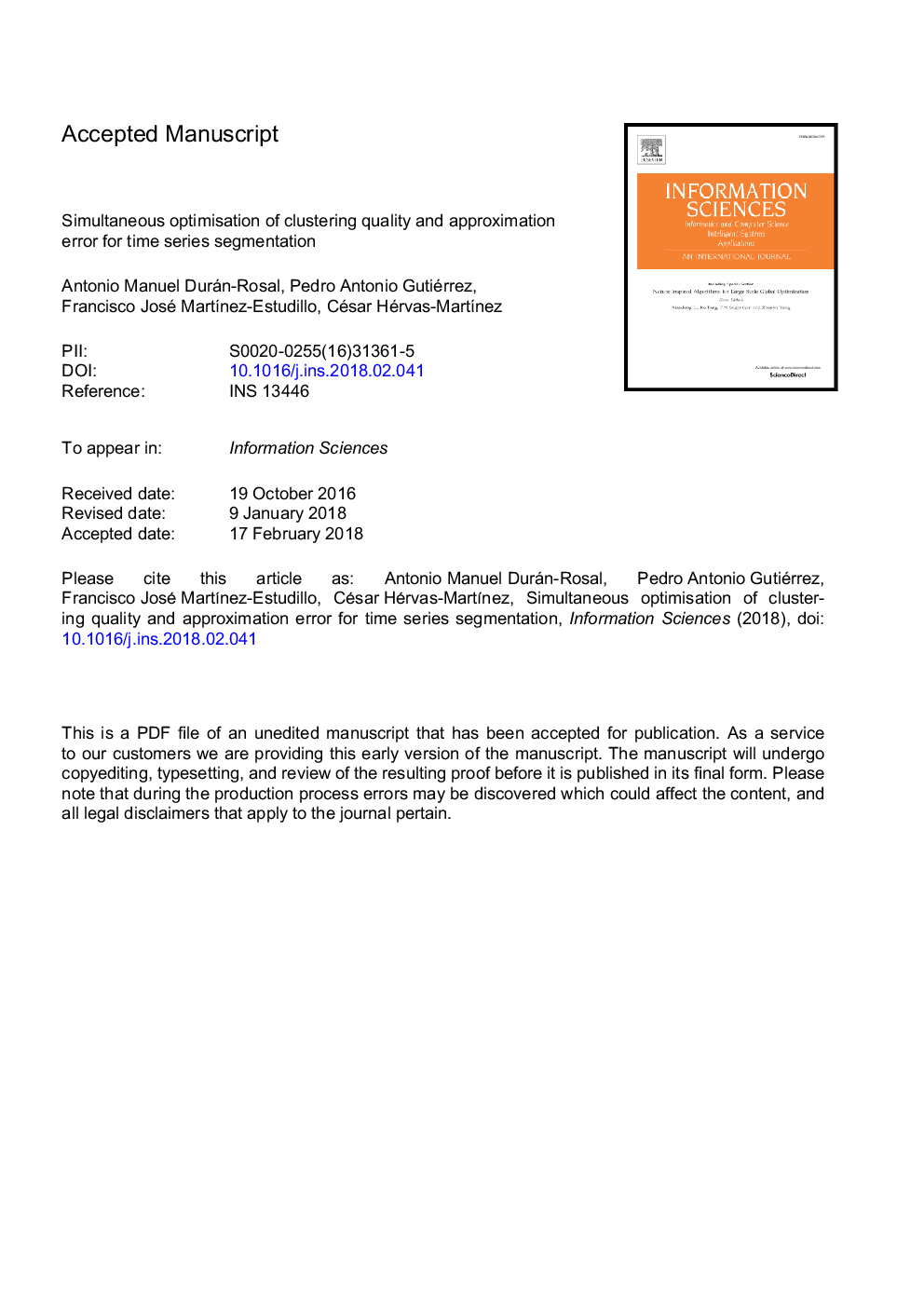| کد مقاله | کد نشریه | سال انتشار | مقاله انگلیسی | نسخه تمام متن |
|---|---|---|---|---|
| 6856547 | 1437963 | 2018 | 20 صفحه PDF | دانلود رایگان |
عنوان انگلیسی مقاله ISI
Simultaneous optimisation of clustering quality and approximation error for time series segmentation
ترجمه فارسی عنوان
بهینه سازی همزمان از کیفیت خوشه بندی و خطای تقریبی برای تقسیم بندی سری زمانی
دانلود مقاله + سفارش ترجمه
دانلود مقاله ISI انگلیسی
رایگان برای ایرانیان
کلمات کلیدی
تقسیم سری زمانی، بهینه سازی چند منظوره، خوشه بندی محاسبات تکاملی،
ترجمه چکیده
تقسیم بندی سری زمانی برای نشان دادن یک سری زمانی با استفاده از مجموعه ای از بخش ها انجام می شود. برخی از محققان تقسیم بندی را با تقریب هر بخش با یک مدل ساده (به عنوان مثال یک درونالیزاسیون خطی) انجام می دهند، در حالی که دیگران تلاش خود را برای به دست آوردن گروه های همگن از بخش ها متمرکز می کنند تا بتوان الگوهای یا رفتارهای معمول را شناسایی کرد. فرضیه اصلی این مقاله این است که هر دو هدف در تعارض هستند، بنابراین تقسیم بندی سری زمانی پیشنهاد می شود که از دیدگاه چند هدفه ای که هر دو هدف در نظر گرفته می شود، مورد توجه قرار گیرد و متخصص می تواند راه حل مورد نظر را از جبهه پارتو از تقسیم بندی های مختلف انتخاب کند. یک الگوریتم تکاملی چند منظوره خاص برای تصمیم گیری برش نقاط از بخش ها طراحی شده است، یکپارچه سازی یک الگوریتم خوشه بندی برای ارزیابی تناسب اندام. اعتبار تجربی روش شناسی شامل سه سری زمان مصنوعی و سه سری زمانی از مسائل دنیای واقعی است. معیارهای ارزیابی کیفیت خوشه بندی نه در مقایسه با الگوریتم مناسب برای تصمیم گیری مناسب تر است. الگوریتم پیشنهادی عملکرد خوب برای هر دو کیفیت خوشه بندی و خطای بازسازی را نشان می دهد، نتایج سایر گزینه های یک جانبه ای از پیشرفته را بهبود می بخشد و نتایج بهتر را نشان می دهد تا یک ترکیب خطی با وزن ساده از هر دو عملکرد تناسب مربوطه.
موضوعات مرتبط
مهندسی و علوم پایه
مهندسی کامپیوتر
هوش مصنوعی
چکیده انگلیسی
Time series segmentation is aimed at representing a time series by using a set of segments. Some researchers perform segmentation by approximating each segment with a simple model (e.g. a linear interpolation), while others focus their efforts on obtaining homogeneous groups of segments, so that common patterns or behaviours can be detected. The main hypothesis of this paper is that both objectives are conflicting, so time series segmentation is proposed to be tackled from a multiobjective perspective, where both objectives are simultaneously considered, and the expert can choose the desired solution from a Pareto Front of different segmentations. A specific multiobjective evolutionary algorithm is designed for the purpose of deciding the cut points of the segments, integrating a clustering algorithm for fitness evaluation. The experimental validation of the methodology includes three synthetic time series and three time series from real-world problems. Nine clustering quality assessment metrics are experimentally compared to decide the most suitable one for the algorithm. The proposed algorithm shows good performance for both clustering quality and reconstruction error, improving the results of other mono-objective alternatives of the state-of-the-art and showing better results than a simple weighted linear combination of both corresponding fitness functions.
ناشر
Database: Elsevier - ScienceDirect (ساینس دایرکت)
Journal: Information Sciences - Volumes 442â443, May 2018, Pages 186-201
Journal: Information Sciences - Volumes 442â443, May 2018, Pages 186-201
نویسندگان
Antonio Manuel Durán-Rosal, Pedro Antonio Gutiérrez, Francisco José MartÃnez-Estudillo, César Hérvas-MartÃnez,
